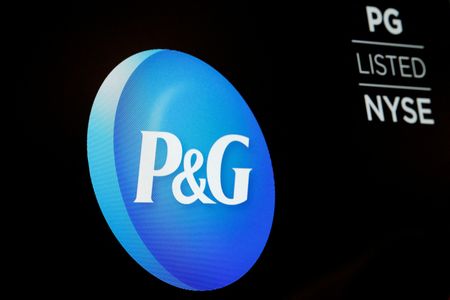By Jessica DiNapoli and Ananya Mariam Rajesh
(Reuters) -Procter & Gamble Co’s customers, particularly in the United States, continued to show little resistance to repeated price hikes helping the Tide detergent maker boost its sales forecast and third-quarter margins.
The maker of Pampers diapers, Pantene shampoo and Oral-B toothpaste raised average prices across its categories by 10% during the quarter, and saw overall volumes fall just 3%.
The reopening in China, P&G’s second-biggest market after the U.S., helped moderate volume declines, executives said, adding that they expect “a number of twists and turns along the way” as the country restarts.
Executives in a conference call flagged new products like Native body wash, Gillette Labs exfoliating razors and updated cardboard packaging as driving growth.
Europe, however, saw steeper volume declines of 7% as consumers shifted their spending to private label rivals, which are holding back on price hikes, executives said.
“A concern for the company, which is taking price globally including the U.S., is at what point do we see (consumer demand) not work in their favor,” said Samantha Palm, a portfolio manager at San Francisco-based Parnassus Investments. “It’s not that we’re saying taking price is not justified, but taking price in what could be a recessionary environment in 2023, 2024 could have implications for consumers.”
Palm said the implications could be that P&G sees sharper volume declines or “more significant discounting.”
The Cincinnati-based company beat Wall Street targets for quarterly results and sweetened the pot for investors by raising the upper end of its 2023 share buyback target to between $7.4 billion and $8 billion, sending its shares up 3.9% to $156.73 in early afternoon trading.
Consumer goods makers, typically the last to see demand hit by economic slowdowns, have hiked prices repeatedly to pass on steep input costs stemming from supply-chain snags and worsened by the Ukraine crisis.
P&G’s gross margin rose by 150 basis points from a year ago, with a 470-basis point bump from the higher pricing.
Shrinking consumer wallets in the face of high inflation have fanned concerns of how much longer shoppers will tolerate rising prices before switching to cheaper, private-label brands.
The decline in P&G’s volumes sold is “obviously driven by pricing,” Chief Financial Officer Andre Schulten said.
“We see consumers being a bit more careful with dosing and drawing down inventories over time,” he said. He later added that shopper behavior is returning to normal, and that he does not anticipate consumers stocking up their pantries like they did during the pandemic.
The fabric and home-care unit, P&G’s biggest, saw sales volumes fall 5%, with average price rising 13%.
Sales in China grew 2% after falling over the past couple of quarters due to pandemic lockdowns. Sales of SK-II, the company’s $100-a-bottle facial serum popular in Asia, is recovering, executives said. But Chinese consumers are not yet returning to travel retail, such as duty-free shops in airports, hurting results for the brand.
Jefferies analyst Kevin Grundy said P&G is “trying to not let expectations get too far ahead because China does move the needle” for the company.
The company lowered its annual cost estimate related to commodity and freight expenses to about $3.5 billion from $3.7 billion, but Schulten said there is “no broad-based relief in input costs”.
“Some (commodities) are down. … Others are going up. Every highly energy intensive material, if you think about caustic soda or ammonium, it’s actually increasing in pricing.”
The company expects fiscal 2023 organic sales growth of about 6%, compared with its previous forecast for a 4% to 5% increase.
P&G maintained its annual earnings forecast of flat to a 4% rise.
(Reporting by Ananya Mariam Rajesh in Bengalaru and Jessica DiNapoli in New York; Editing by Devika Syamnath and Jonathan Oatis)





